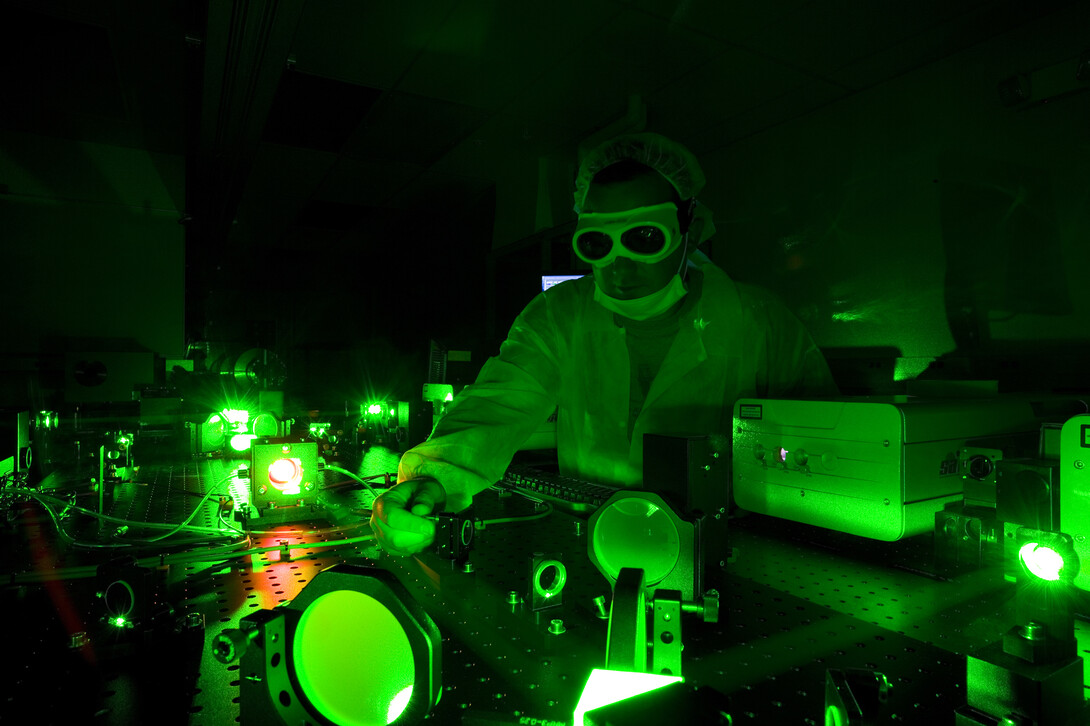
New, more effective vaccines for anthrax and ricin.
Improved information systems that would allow national leaders to make better and faster decisions during security crises or natural disasters.
Stronger assessment tools to allow for timely, thorough responses to outbreaks of foodborne illnesses.
New, innovative tools that would allow decision-makers to better assess responses to the release of chemical, biological, radioactive, nuclear or explosive devices.
These are the goals of just a few of the projects undertaken since the establishment of the University of Nebraska’s National Strategic Research Institute in the fall of 2012. The institute, a collaboration between the University of Nebraska and the United States Strategic Command, has highlighted numerous accomplishments in its first annual report, available on the NSRI website.
UNL researchers featured in the report include Laurence Rilett, Mario Scalora, Jeyamkondon Subbiah and Donald Umstadter.
Overall, faculty from across the university have attracted more than $9 million in contract funding to pursue 22 different projects related to the chief mission of the National Strategic Research Institute to support research for combating weapons of mass destruction.
“We launched the National Strategic Research Institute a year and a half ago with the goal of leveraging the talents and expertise of our faculty for the benefit of our partners at USSTRATCOM and the Department of Defense. I’m pleased that at this early stage, we are doing that very effectively,” said James B. Milliken, NU president. “NSRI has engaged a range of diverse faculty who are committed to supporting our men and women in uniform and improving national security. Because of their work, and the leadership and commitment of our founding executive director, Bob Hinson, the NSRI is off to an incredible start. I am confident we will see great things from this important new institute and the faculty associated with it.”
The National Strategic Research Institute is the newest of 13 University-Affiliated Research Centers across the United States. NSRI focuses on five core areas of expertise demonstrated by NU faculty: nuclear detection and forensics; detection of chemical and biological weapons; passive medical defense against weapons of mass destruction; consequence management; and space, cyber and telecommunications law.
“The establishment of the NSRI at the University of Nebraska has created a significant opportunity for the university faculty and researchers to contribute directly to the combating weapons of mass destruction research and technology requirements of our defense partners and other federal agencies,” said Robert C. Hinson, a retired U.S. Air Force Lieutenant General and executive director of NSRI. “The established core competencies reflect a very real mission area concern of USSTRATCOM and other federal agencies with assigned roles and responsibilities for addressing significant national security requirements for combating weapons of mass destruction.”
The United States Strategic Command is charged with combating threats to the American public, including weapons of mass destruction.
“From sensing the threat to eliminating the materials, we face a challenge that is multi-dimensional and complex. We recognize this is a long-term problem that will require focused research, analysis, experimentation and testing,” said Steve Callicutt, USSTRATCOM director for capability and resource integration. “To that end, we established the University-Affiliated Research Center to build the body of knowledge this nation will need to maintain security both at home and abroad.”
The 22 NSRI-affiliated projects, called “task orders,” being performed at the University of Nebraska capitalize on the expertise of some of NU’s most outstanding faculty. Those projects include:
Umstadter, professor of physics and astronomy, is pioneering the science, technology and applications of extreme light with the high-powered Diocles laser — work that could allow for better detection of nuclear materials.
Subbiah, associate professor in the departments of Biological Systems Engineering and Food Science and Technology, is conducting research that could lead to more thorough and rapid responses to foodborne outbreaks affecting Department of Defense or Department of State personnel in the United States or other countries.
Kenneth Bayles, professor of pathology and microbiology at the University of Nebraska Medical Center, is conducting research in the area of a next-generation anthrax vaccine.
James Talmadge, UNMC professor of pathology and microbiology, is working on strategies that can better protect soldiers from biological weapons.
Douglas Derrick, assistant professor of information technology innovation at the University of Nebraska at Omaha, is working on a project that could enable more rapid understanding, risk assessment and decision-making for national leaders in the event of hostile enemy actions or man-made or natural disasters.
In addition, Gina Ligon, assistant professor of management at UNO, serves as the lead faculty member for a new, first-of-its-kind leadership program at UNO that directly supports the professional education and development of civilian leaders at USSTRATCOM. The program focuses on leadership, critical decision-making, team-building, collaboration and project management, interactions with state and federal political leaders and will conclude with completion of an assigned research project report over a challenging 13-week curriculum.
All 13 UARCs in the country are affiliated with leading research universities and were established to provide or maintain essential engineering, research and/or development capabilities through a long-term, strategic partnership with the Department of Defense. Massachusetts Institute of Technology, Johns Hopkins University and Penn State University — all national leaders in research and development expenditures financed by the Department of Defense — are among the other universities hosting UARCs.











